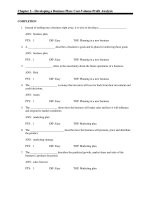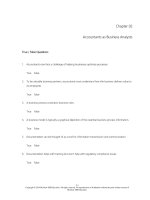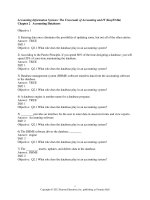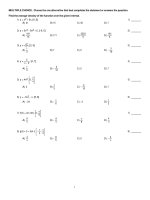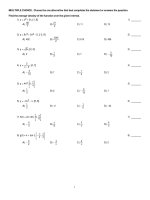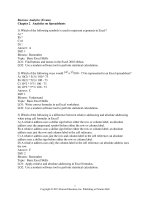Accounting information for business decisions 1st edition cunningham test bank
Bạn đang xem bản rút gọn của tài liệu. Xem và tải ngay bản đầy đủ của tài liệu tại đây (257.84 KB, 11 trang )
Chapter 2—Developing a Business Plan: Cost-Volume-Profit Analysis
COMPLETION
1. Instead of rushing into a business right away, it is wise to develop a ____________________.
ANS: business plan
PTS: 1
DIF: Easy
TOP: Planning in a new business
2. A ____________________ describes a business’s goals and its plans for achieving those goals.
ANS: business plan
PTS: 1
DIF: Easy
TOP: Planning in a new business
3. ____________________ refers to the uncertainty about the future operations of a business.
ANS: Risk
PTS: 1
DIF: Easy
TOP: Planning in a new business
4. The ____________________ is money that investors will receive back from their investment and
credit decisions.
ANS: return
PTS: 1
DIF: Easy
TOP: Planning in a new business
5. The ____________________ shows how the business will make sales and how it will influence
and respond to market conditions.
ANS: marketing plan
PTS: 1
DIF: Easy
TOP: Marketing plan
6. The _________________________ describes how the business will promote, price and distribute
the product.
ANS: marketing strategy
PTS: 1
DIF: Easy
TOP: Marketing plan
7. The ____________________ describes the predicted growth, market share and sales of the
business’s products by period.
ANS: sales forecast
PTS: 1
DIF: Easy
TOP: Marketing plan
8. The _________________________ section of a business plan includes a description of the
relationships between the business, its suppliers, its customers, as well as a description of how the
business will develop, service, protect and support its products or services.
ANS: business operations
PTS: 1
DIF: Easy
TOP: Operating plan
9. The ____________________ section of a business plan identifies the business’s capital
requirements and sources of capital, as well as to describe the business’s projected financial
performance.
ANS: financial plan
PTS: 1
DIF: Moderate
TOP: Financial plan
10. ____________________ is the business’s funding.
ANS: Capital
PTS: 1
DIF: Moderate
TOP: Sources of capital
11. ____________________ is the business’s funding that will be repaid within a year or less.
ANS: Short-term capital
PTS: 1
DIF: Moderate
TOP: Sources of capital
12. ____________________ is the business’s funding that will be repaid after more than a year.
ANS: Long-term capital
PTS: 1
DIF: Moderate
TOP: Sources of capital
13. ______________________________ shows how profit is affected by changes in sales volume,
selling price of products and the various costs of the business.
ANS: Cost-volume-profit analysis
PTS: 1
DIF: Difficult
TOP: Cost-volume-profit analysis
14. The ______________________________ is the difference between the total sales revenue and
total variable costs.
ANS: total contribution margin
PTS: 1
DIF: Difficult
TOP: Contribution margin
15. The ______________________________ is the difference between the sales revenue per unit and
the variable costs per unit.
ANS: contribution margin per unit
PTS: 1
DIF: Moderate
TOP: Contribution margin
TRUE/FALSE
1. The first step in starting a business is to develop a business plan.
ANS: T
business
PTS: 1
DIF: Easy
TOP: Planning in a new
2. The first step in starting a business is to set up a corporation.
ANS: F
business
PTS: 1
DIF: Easy
TOP: Planning in a new
3. A business plan is a static document. Once created it should not need to be updated.
ANS: F
business
PTS: 1
DIF: Easy
TOP: Planning in a new
4. A business plan typically includes a description of the business, a marketing plan, an operating
plan, an environmental management plan and a financial plan.
ANS: T
business
PTS: 1
DIF: Moderate
TOP: Planning in a new
5. A business plan should be viewed as an opportunity to identify mistakes before they could happen.
ANS: T
business
PTS: 1
DIF: Moderate
TOP: Planning in a new
6. Cost behaviour activity affects the way costs behave.
ANS: T
PTS: 1
DIF: Moderate
TOP: Cost behaviour
7. In cost behaviour cost affects the way costs behave.
ANS: F
PTS: 1
DIF: Moderate
TOP: Cost behaviour
8. Fixed costs per unit will remain constant as activity changes.
ANS: F
PTS: 1
DIF: Moderate
TOP: Fixed costs
9. A fixed cost does not respond to changes in an activity such as sales volume.
ANS: T
PTS: 1
DIF: Moderate
TOP: Fixed costs
10. A fixed cost responds directly to changes in an activity such as sales volume.
ANS: F
PTS: 1
DIF: Moderate
11. Fixed costs per unit will change as activity changes.
TOP: Fixed costs
ANS: T
PTS: 1
DIF: Moderate
12. Variable costs will remain constant per unit as activity changes.
ANS: T
PTS: 1
DIF: Moderate
TOP: Fixed costs
TOP: Variable costs
13. Variable costs per unit will change as activity changes.
ANS: F
PTS: 1
DIF: Moderate
TOP: Variable costs
14. A variable cost responds directly to changes in an activity such as sales volume.
ANS: T
PTS: 1
DIF: Moderate
TOP: Variable costs
15. Total costs are the sum of the fixed costs and variable costs.
ANS: T
PTS: 1
DIF: Moderate
TOP: Total costs
16. Contribution margin is the amount leftover after a sale to cover the fixed costs, which then
contributes toward profit.
ANS: T
PTS: 1
DIF: Moderate
TOP: Contribution margin
17. Sales less fixed costs equal contribution margin.
ANS: F
PTS: 1
DIF: Moderate
TOP: Contribution margin
18. Sales less variable costs equal contribution margin.
ANS: T
PTS: 1
DIF: Moderate
TOP: Contribution margin
19. All contribution margin created past the breakeven point will contribute towards profit.
ANS: T
PTS: 1
DIF: Moderate
TOP: Contribution margin
20. All contribution margin created prior to the breakeven point will contribute towards covering fixed
costs.
ANS: T
PTS: 1
DIF: Moderate
TOP: Contribution margin
21. All contribution margin created prior to the breakeven point will contribute towards profit.
ANS: F
PTS: 1
DIF: Moderate
TOP: Contribution margin
22. Only fixed costs are deducted from the selling price per unit, with the result then taken times sales
volume in the profit equation for determination of profit.
ANS: F
PTS: 1
volume to achieve a target profit
DIF: Moderate
TOP: Finding the unit sales
23. The breakeven point is the point that total revenues equal total costs.
ANS: T
point
PTS: 1
DIF: Moderate
TOP: Finding the break-even
24. The breakeven point is the point that total revenues exceed total costs.
ANS: F
point
PTS: 1
DIF: Moderate
TOP: Finding the break-even
25. The breakeven point is the point that total revenues are less than total costs.
ANS: F
point
PTS: 1
DIF: Moderate
TOP: Finding the break-even
26. The breakeven point is the point that total revenues equal target profit.
ANS: F
point
PTS: 1
DIF: Moderate
TOP: Finding the break-even
27. If a business were concerned about raising the price of their goods, CVP analysis would help
determine the impact on profits and the resulting changes in costs.
ANS: T
analysis
PTS: 1
DIF: Difficult
TOP: Cost-volume-profit
28. CVP can be an absolute decision making tool. Faced with a change in costs or prices, one need
look only to the CVP results to make a complete decision.
ANS: F
analysis
PTS: 1
DIF: Difficult
TOP: Cost-volume-profit
29. CVP is not an absolute decision making tool. Faced with a change in costs or prices, one should
also consider the impact on customers as well as the CVP results to make a complete decision.
ANS: T
analysis
PTS: 1
DIF: Difficult
TOP: Cost-volume-profit
30. When analysing an alternative set of plans, CVP is but one tool. The impact on customers should
also be considered.
ANS: T
analysis
PTS: 1
DIF: Difficult
TOP: Cost-volume-profit
MULTIPLE CHOICE
1. I. The first step in starting a business is to develop a business plan.
II. The first step in starting a business is to set up a corporation.
III. A business plan is a static document that if done right will not need updating.
IV. A business plan should be viewed as an opportunity to identify mistakes before they occur.
Which of the above is correct?
a. I. only.
b. I. and II only.
c. II and III only.
d. I and IV only.
e. I, II, III and IV.
ANS: D
business
PTS: 1
DIF: Moderate
TOP: Planning in a new
2. The primary concern of creditors and investors is:
a. risk.
b. return.
c. both of the options given
ANS: C
business
PTS: 1
DIF: Easy
TOP: Planning in a new
3. Fixed costs:
a. do not respond to changes in volume.
b. respond in the opposite direction of changes in volume.
c. change in proportion with changes in volume.
d. will always be the same from one period to the next.
ANS: A
PTS: 1
DIF: Moderate
TOP: Fixed costs
4. Barney’s Brick Co. has high fixed costs such as building, machinery and salaries. Barney desires to
minimise the impact of these fixed costs. A strategy for Barney would be?
a. To produce and sell as many units as possible.
b. To downsize.
c. Sell the business to someone else.
d. Lay off the salary employees.
ANS: A
business
PTS: 1
DIF: Moderate
TOP: Planning in a new
5. Which of the following best represents an example of a fixed cost?
a. Equipment.
b. Cost of products sold to customers.
c. Salary plus commission employees.
d. Telephone usage.
ANS: A
PTS: 1
DIF: Difficult
TOP: Fixed costs
6. Variable costs:
a. do not respond to changes in volume.
b. respond in the opposite direction to changes in volume.
c. change in proportion with changes in volume.
d. will always be the same from one period to the next.
ANS: C
PTS: 1
DIF: Moderate
TOP: Variable costs
7. Which of the following best represents an example of a variable cost?
a. Equipment
b. Cost of products sold to customers
c. Salary plus commission employees
d. Telephone usage
ANS: B
PTS: 1
DIF: Difficult
TOP: Variable costs
8. Which of the following costs change is in direct proportion to the volume?
a. Fixed costs and variable costs
b. Variable costs
c. None of the options given
d. Fixed costs
ANS: B
PTS: 1
DIF: Moderate
TOP: Variable costs
9. Barb’s Best Pies sells a meat pie for $5.00. Variable costs are $3.00 per unit and fixed costs for the
period are $4 000. The profit on the 2001st pie sold is:
a. $2.00
b. $5.00
c. $3.00
d. $ - 0 ANS: A
PTS: 1
DIF: Difficult
TOP: Profit calculation
10. Widget World makes a widget that is sells for $10 per unit. The variable costs are $7 per unit.
Assuming the business has normal fixed costs, and the breakeven point is 350 units, what are the
total costs at breakeven?
a. $4 500
b. $3 500
c. $12 000
d. $7 500
ANS: B
point
PTS: 1
DIF: Difficult
TOP: Finding the breakeven
Example 2.1
The information below is used for the following problems.
Leslie's Soccer Balls sells soccer balls for $20 each and incurs variable costs of $15 per ball.
Leslie's break-even point is 40,000 units.
11. Refer to Example 2.1 What is the total of Leslie's fixed costs?
a. $2 000
b. $8 000
c. $20 0000
d. None of the options given
ANS: C
PTS: 1
DIF: Difficult
TOP: Fixed Costs
12. Refer to Example 2.1. What is Leslie's profit when 50,000 units are sold?
a. $50 000
b. $250 000
c. $1 000 000
d. None of the options given
ANS: A
PTS: 1
volume to achieve a target profit
DIF: Moderate
TOP: Finding the unit sales
13. Refer to Example 2.1. What is Leslie's profit when 25,000 units are sold?
a. $500 000
b. $125 000
c. $75 000 loss
d. None of the options given
ANS: C
PTS: 1
volume to achieve a target profit
DIF: Easy
TOP: Finding the unit sales
Example 2.2
The information below is used for the following problems.
Garrison's Gaskets has variable costs of $2 per unit and fixed costs of $40,000. Garrison's selling
price is $5 per unit.
14. Refer to Example 2.2. What is Garrison's breakeven point?
a. 8 000 units
b. 20 000 units
c. 13 333 units
d. None of the options given
ANS: C
point
PTS: 1
DIF: Moderate
TOP: Finding the breakeven
15. Refer to Example 2.2. How many units will Garrison’s have to sell in order to earn a profit of
$100,000?
a. 33,333 units
b. 46,667 units
c. 20,000 units
d. 28,000 units
ANS: B
PTS: 1
volume to achieve a target profit
DIF: Moderate
TOP: Finding the unit sales
16. Refer to Example 2.2. How much profit will Garrison’s earn if it cuts its selling price to $3 per
unit, and sells 100,000 units?
a. $300 000
b. $100 000
c. $60 000
d. None of the options given
ANS: C
PTS: 1
volume to achieve a target profit
DIF: Moderate
TOP: Finding the unit sales
SHORT ANSWER
1. What are the three main purposes of a business plan? Discuss each of the three purposes.
ANS:
First, the business plan helps the entrepreneur visualise and organise the business and its
operations. It helps to evaluate the plan, develop new ideas, and refine the plan. Mistakes may be
identified and corrected prior to implementing the plan.
Second, the business plan serves as a ‘benchmark’ for measuring the actual performance of the
business. Plans for future activities can then be modified.
Third, the business plan helps the business obtain financing. The business plan helps creditors and
investors assess the expected risk and return associated with the business.
PTS: 1
DIF: Moderate
TOP: Planning in a new business
2. What are the two primary concerns of investors? Discuss each.
ANS:
One concern is the level of risk associated with the investment. Risk refers to the uncertainty
existing about the future operations of the business. The other concern is return. Return refers to
the money that the investor will receive back from their investment and credit decisions.
PTS: 1
DIF: Moderate
TOP: Planning in a new business
3. What are the four parts of the business plan? Discuss each.
ANS:
The four parts of the business plan are a description of the business, a marketing plan, an operating
plan, an environmental management plan and a financial plan.
The description of the business discloses the type of business and product. It describes how the
business is organised. It discloses where the business is located. The objectives of the business are
listed, along with potential customers.
The marketing plan shows how the business will influence and respond to market conditions. It
provides evidence of the demand for the business’s product or services. It describes the current and
expected competition in the market and relevant government regulations.
The operating plan includes a description of the relationships between the business, its suppliers,
and its customers, along with a description of how the business will develop, service, protect and
support its products or services. It also includes any other influences on the operations of the
business.
The financial plan discloses the capital requirements, sources of capital and to describe the
business’s projected financial performance.
PTS: 1
DIF: Difficult
TOP: Planning in a new business
4. What is the purpose of the description of the business section of the business plan?
ANS:
The description of business section of the business plan discloses the type of business and product.
It describes how the business is organised. It discloses where the business is located. The
objectives of the business are listed, along with potential customers. The organisation of a business
and its personnel can have a major impact on the success of the business. The investors need to be
able to evaluate the items contained in this part of the business plan in order to assess the long-term
potential of the business.
PTS: 1
DIF: Moderate
TOP: Planning in a new business
5. What is the purpose of the marketing plan section of the business plan?
ANS:
The marketing section of the business plan shows how the business will influence and respond to
market conditions. It provides evidence of the demand for the business’s product or services. It
describes the current and expected competition in the market and relevant government regulations.
This section receives considerable attention from creditors and investors, as the marketing of a
product is critical to the long-term success of a business. This information helps the manager think
about the business’s activities related to sales. It shows investors and creditors how well the
manager has thought about the business’s sales potential and how the business will attract and sell
to customers.
PTS: 1
DIF: Moderate
TOP: Marketing Plan
6. Doggie Donuts sells treats for pets for $5 per box. The variable costs per box are $3. Doggie
Donuts' fixed costs total $20 000.
a.
b.
c.
Calculate the contribution margin per box.
Calculate the break-even point in boxes.
Calculate the profit that Doggie would earn if sales total 30,000 units.
ANS:
a. $2 = $5 – $3
b. 10 000 units = $20 000/$2 per unit
c. $40 000 = $2 per unit 30 000 units – $20 000
PTS: 1
DIF: Difficult
TOP: Finding the break-even point
7. Bill produces a miracle tool. His variable costs are $20 per unit and his fixed costs are $25,000. His
break-even point is 30 000 units.
a.
b.
c.
What is Bill's selling price per unit?
What is Bill's profit at 50 000 units of sales?
What would Bill's profits at 50 000 units of sales be if Bill were able to reduce his
variable costs by $5 per unit?
ANS:
a. 30,000 units = 25 000/contribution margin per unit
Contribution margin per unit = $0.83
Selling price per unit – $20 = $0.83
Selling price per unit = $20.83
b. ($0.83 50,000) – $25,000 = $16 500
c. [($20.83 – $15.00) 50,000] – $25 000=$266 500
PTS: 1
DIF: Difficult
TOP: Finding the break-even point
8. Bob's variable costs are $7 per unit. His selling price is $9 per unit. His breakeven point is 25 000
units.
a.
b.
c.
What is the amount of Bob's fixed costs?
What is Bob's profit when he sells 30 000 units?
What would Bob's profit be if he were able to raise prices to $10 per unit and had
sales of 40 000 units?
ANS:
a. 25 000 = fixed costs/($9 – $7)
b.
c.
Fixed costs = $50 000
($2 30 000) – $50 000 = $10 000
($3 40 000) – $50 000 = $70 000
PTS: 1
DIF: Difficult
TOP: Finding the break-even point
9. If variable costs increase, and fixed costs and the selling price remain constant, what will happen to
the breakeven point? What will happen to profits?
ANS:
If variable costs rise, the contribution margin will fall. This will cause the breakeven point to rise.
The same level of profit will be attained with higher unit sales.
PTS: 1
DIF: Difficult
TOP: Cost-volume-profit analysis
10. If fixed costs increase, variable costs and the selling price remain constant, what will happen to the
breakeven point? What will happen to profits?
ANS:
If fixed costs increase, it will take more unit sales to breakeven. More units will have to be sold to
attain a profit.
PTS: 1
DIF: Moderate
TOP: Cost-volume-profit analysis
11. Suppose that your business profits are less than the desired amount. What actions might you take to
raise profits, if you do not want to change products?
ANS:
There are only a few actions that a business might take. The following are some of the possible
alternatives. If the business can raise prices without hurting the sales volume in units, the
contribution margin per unit would rise, resulting in higher profits. The business might consider
investing in a new automated production facility, which would lower variable costs. If the
increased contribution margin per unit more than offsets the increased fixed costs, profits will rise.
If the business increases advertising, fixed costs will rise. If the advertising results in an increased
sales volume, the increased total contribution margin may increase more than the increased fixed
costs. This would result in an increase in profits.
PTS: 1
DIF: Moderate
TOP: Cost-volume-profit analysis



